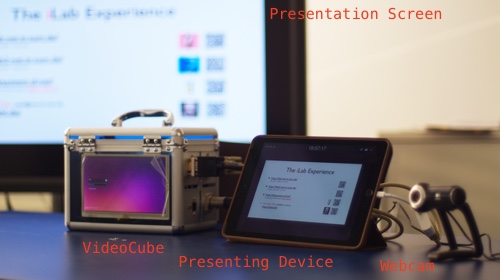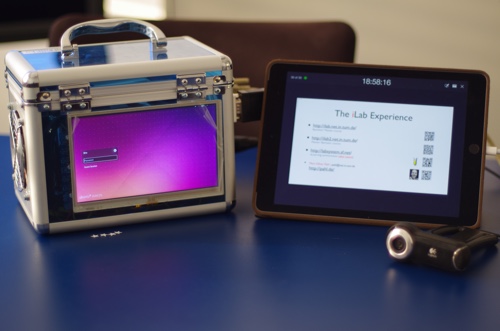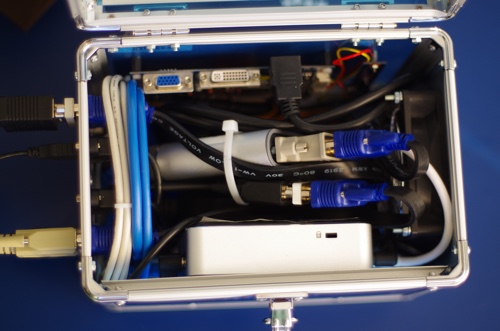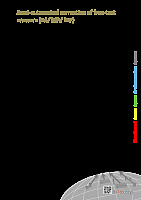The VideoCube (2015-)
This project is currently under construction. More information and videos will follow once we have running prototypes that demonstrate a wider range of the technology.
In 2008, I started the media portal. One aim of the project is providing students with visual feedback to their presentations. Another objective is providing recordings for lectures.
The VideoCube puts this recording effort another step further.

Recording with the VideoCube - Setup.
Over the years two things turned out to be problematic with the recording workflow using a screen capture software on the presentation laptop, an HD video camera, and a speaker microphone that the speaker attaches to her cloths.
- We often forget starting the screen capture software, or a student wants to use his own laptop without our screen capture software.
- The HD video camera has to be mounted, and the data have to be copied from its hard disk for further processing by my portal backend.
- The attached microphone tends to make students nervous sometimes. This prevents some of the students from accepting to be recorded.

The VideoCube equipment.
For the given reasons, I decided to develop a new recording hardware, the VideoCube. The VideoCube is a former box for CDs that is filled with hardware and has a touch screen for control.
The VideoCube box contains:
- A frame grabber that captures the video from the presentation device.
- A VGA splitter that sends the signal to the presentation screen (e.g. beamer), and to the frame grabber.
- An Intel NUC for capturing the video.
- A touch screen for controlling the recording.
Major advantages of the VideoCube compared to the previous recording workflow are:
- The presentation video and the camera are always both recorded.
- Both streams are automatically synchronized, making pot processing for synchronization obsolete. Such synchronization is currently the only manual step in the media portal backend's workflow.
- As we use a webcam that is stationary mounted as recording device, no further setup is required but plugging the installed USB cable in.
- The VideoCube can directly record to the target folder on media. For the future even live streaming of events is planned.
- The (student) speakers are not disturbed by the recording at all as no additional equipment is required from their side (such as the attached speaker microphone).

The insight of the VideoCube.
With the VideoCube implementation at Technische Universität München I am supported by:
- Hardware creation and assembly
- Martin Meir (RBG): hardware assembly
- Richard Haensch (RBG): box assembly
- Ernst Graf (RBG): moulding of the aluminium side plates
- Software
- Sina Shafei (student assistant): software
- Andreas Hubel (student assistant): advise
